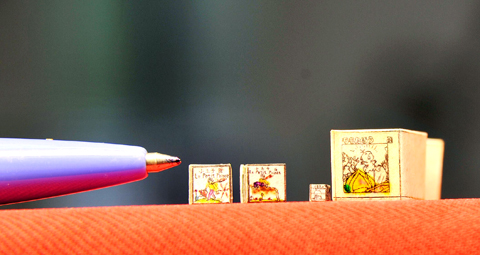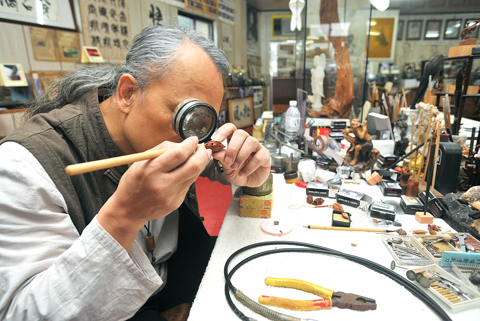When artist Chen Forng-shean (陳逢顯) paints and carves he needs to hold his breath and use a magnifying glass because of the materials he works with — hair strands, ant abdomens and sesame seeds.
The 54-year-old has produced some of the tiniest art in existence today, penning miniature books that weigh less than 1 gram and sculpting animals smaller than the eye of a needle.
“I want to make miniature art because it is more challenging and innovative,” Chen said at his studio in suburban Taipei.

PHOTO: PATRICK LIN, AFP
It is a personal obsession and Chen spends all his spare time at his work station, which is occupied by a large array of magnifying glasses, carving needles and paintbrushes as thin as a hair.
The artist, who has a day job at the Central Bank’s engraving plant, recently finished drawing both Taiwan and China’s pavilions at the Shanghai World Expo on a grain of rice, with a small crowd of people outside.
“It’s historical for both Taiwan and China to be present at the event and I hope my work can bear witness to their improving ties,” he said.

PHOTO: PATRICK LIN, AFP
Miniature art can be dated back thousands of years in China, but its popularity soared in the Ming Dynasty (1368 to 1644), when noblemen started collecting meticulous ivory and walnut carvings.
“I was fascinated by the tiny curios I saw in the museums,” Chen said, explaining how a graduate from a vocational art school came to love miniatures with millennia-old traditions.
It is a time-consuming process and in the 30 years he has spent so far honing his special craft, Chen has created just 120 pieces.
It took him three months recently to complete a tiger figurine from artificial resin measuring just 1.2mm.
The animal looks vivid with its mouth wide open, baring white teeth and sticking out a red tongue.
The work he is most proud of is the recreation of ten literary masterpieces in mini versions, including the Chinese classic 300 Tang Dynasty Poems and the famous French novella Le Petit Prince.
“The poetry book alone took two years because it was strenuous to write such tiny characters. It was exhausting and I almost wanted to give up,” Chen said.
The artist enjoys experimenting with unusual materials, including insects, which are in ample supply in a big garden outside his studio.
He carved English poet William Blake’s verse “to see a world in a grain of sand” in Chinese on a grain of sand and wrote chunky complex Chinese characters on ants and the wings of bees and dragonflies.
On a match head, he drew former US president Bill Clinton and White House intern Monica Lewinsky to poke fun at the infamous affair in a reference to the Chinese slang “dry wood fierce fire” used to describe fiery illicit relations.
“I will keep making miniature art for as long as I can, hopefully for at least ten more years,” a fit-looking Chen said. “I’ve got good eyesight.”

Taipei, New Taipei City, Keelung and Taoyuan would issue a decision at 8pm on whether to cancel work and school tomorrow due to forecasted heavy rain, Keelung Mayor Hsieh Kuo-liang (謝國樑) said today. Hsieh told reporters that absent some pressing reason, the four northern cities would announce the decision jointly at 8pm. Keelung is expected to receive between 300mm and 490mm of rain in the period from 2pm today through 2pm tomorrow, Central Weather Administration data showed. Keelung City Government regulations stipulate that school and work can be canceled if rain totals in mountainous or low-elevation areas are forecast to exceed 350mm in

EVA Airways president Sun Chia-ming (孫嘉明) and other senior executives yesterday bowed in apology over the death of a flight attendant, saying the company has begun improving its health-reporting, review and work coordination mechanisms. “We promise to handle this matter with the utmost responsibility to ensure safer and healthier working conditions for all EVA Air employees,” Sun said. The flight attendant, a woman surnamed Sun (孫), died on Friday last week of undisclosed causes shortly after returning from a work assignment in Milan, Italy, the airline said. Chinese-language media reported that the woman fell ill working on a Taipei-to-Milan flight on Sept. 22

COUNTERMEASURE: Taiwan was to implement controls for 47 tech products bound for South Africa after the latter downgraded and renamed Taipei’s ‘de facto’ offices The Ministry of Foreign Affairs is still reviewing a new agreement proposed by the South African government last month to regulate the status of reciprocal representative offices, Minister of Foreign Affairs Lin Chia-lung (林佳龍) said yesterday. Asked about the latest developments in a year-long controversy over Taiwan’s de facto representative office in South Africa, Lin during a legislative session said that the ministry was consulting with legal experts on the proposed new agreement. While the new proposal offers Taiwan greater flexibility, the ministry does not find it acceptable, Lin said without elaborating. The ministry is still open to resuming retaliatory measures against South

1.4nm WAFERS: While TSMC is gearing up to expand its overseas production, it would also continue to invest in Taiwan, company chairman and CEO C.C. Wei said Taiwan Semiconductor Manufacturing Co (TSMC) has applied for permission to construct a new plant in the Central Taiwan Science Park (中部科學園區), which it would use for the production of new high-speed wafers, the National Science and Technology Council said yesterday. The council, which supervises three major science parks in Taiwan, confirmed that the Central Taiwan Science Park Bureau had received an application on Friday from TSMC, the world’s largest contract chipmaker, to commence work on the new A14 fab. A14 technology, a 1.4 nanometer (nm) process, is designed to drive artificial intelligence transformation by enabling faster computing and greater power